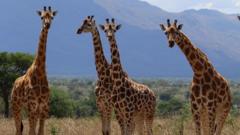Scientists have uncovered a remarkable revelation about giraffes, long considered a single species: four species of these majestic animals exist, as reported by the International Union for Conservation of Nature (IUCN). This new classification, backed by research into genetic diversity and ecological factors, reflects a deeper understanding of the complexities within giraffe populations.
The journey to this conclusion involved careful examination of the skulls and head shapes of various giraffe populations, revealing enough genetic variation to warrant recognition of four distinct species. Researchers examined the influence of geographical barriers such as deserts, rivers, and valleys, which could have led to the separate evolutionary paths of these four groups over time.
Meet the Southern giraffe, one of the newly recognized species, found in regions across South Africa, Angola, and southern Botswana, among others. Geographic factors like the Kunene and Zambezi rivers and rainforests of the Congo Basin contributed to their isolation from other giraffe groups.
The second newly identified type is the Reticulated giraffe, which roams the open savannas and forests of Kenya, Somalia, and Ethiopia. According to scientists, natural barriers such as the Tana River and Ethiopia’s mountainous terrains have kept this species genetically distinct.
Following closely is the Northern giraffe, inhabiting western Ethiopia, eastern South Sudan, Uganda, and central Kenya. Key geographical features like the Nile River and Lake Victoria, along with migration patterns, have helped isolate this species.
Lastly, the Masai giraffe, characterized by its decorative leaf-patterned coat, occurs in Kenya, Tanzania, and Uganda, separated from the Northern giraffe by significant waterways.
The IUCN emphasizes that understanding these genetic subdivisions is crucial for effective conservation. As a single entity, giraffes were considered vulnerable to extinction, but with this new classification, conservation efforts can be better tailored to each species’ unique circumstances. The organization anticipates a thorough re-evaluation of the conservation status and strategies for these newly categorized giraffe species.























